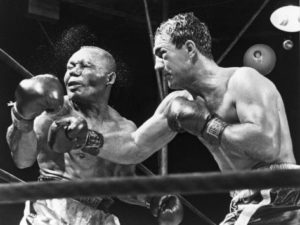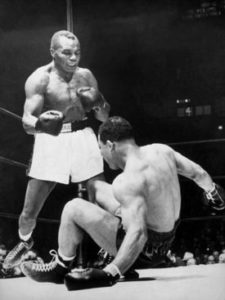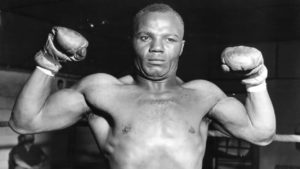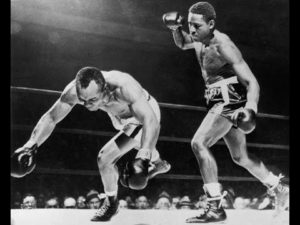Jersey Joe Walcott – Weaknesses

Head movement
Wary of head movement
Head movement was a favourite of Walcott as a method of defending against punches, making him a very slippery target. Opponents had to be conscious of the fact that Walcott was dangerous when he was moving his head, as he loved to spring up with punches after slipping and dipping, catching his opponent off guard. However, fighters could find success finding him punching as he bent at the waist, before he came back up with punches.
As Walcott was extremely reactive to jabs, because he loved to counter them. So committing to jabs, usually wasn’t an advisable thing to do against Walcott, but jab feints served the same purpose as a jab, without the same risk. Jab feints could be used to encourage Walcott into bending, and a quick right hand could catch him at the point at which he’s bent over, and his momentum has yet to move back from where it came from. Stepping forward, slightly to the right, would cause the angle of the punch to directly meet Walcott’s head movement back to its starting position, meaning he would move right into the punch and there was no escape route.
Rather than focusing on the footwork though, the main point is to make sure that the direction of the punch directly follows the direction that his head moved to, specifically because of the fact that Walcott would usually move it back to centre from the exact same way it came from, and the punch would meet him head on.

The counter-puncher Jersey Joe Walcott was most dangerous when he was on the ‘defensive’
Countering slipping
The jab could also be used to get Walcott to slip to the side, and a swift right to the position where his head will be moving to, rather than centrally where it is, could catch him out. Walcott was exceptionally vulnerable to this after he stepped backwards, due to the fact that it’s more difficult to quickly shift from side to side in a side-on stance.
In some ways, Walcott was over-reliant on head movement because it resulted in him establishing a solid pattern, and patterns present opportunities. But combined with his usually-efficient footwork, Walcott remained an elusive and slippery customer to the point that scientific fighters like Joe Louis and Ezzard Charles struggled to adapt to his patterns.
After dipping
Walcott could also be caught after dipping down to the side to avoid hooks, or punches from outside angles. This was mostly due to the fact that he was naturally usually seeking to move his head back to the centre, but this would put him directly in place for the hook. Standing straight up after dipping elevated his centre of gravity, increasing the time it takes to take control of his moving momentum, as well as making himself a big target. Against combination-punchers such as Louis, it was risky relying on one defensive manoeuvre to get the job done, and it was much safer to keep moving, until you’re out of range, or at least assured of safety.
Opposite side counters
Low angle right
There are two ways that same hand counters could be used against Jersey Joe. Firstly, the low angled right hand counter was tremendously useful against Walcott after he threw his own right. This was due to the fact that Walcott would throw the whole right side of his body into the punch, for power. Inevitably, Walcott would square up. To counteract this and remain elusive, Walcott would bend down to his left to take his head off of centre, which makes much logical sense. But this would move him directly into his opponent’s low angle right. Rocky Marciano had much success with this counter in their first fight.
Countering loaded rights
The alternative, was to counter Walcott’s right as he loaded up to throw his own. Walcott liked to load up a lot of weight in his right leg to build up power for his right hands. This was okay when he was countering jabs, due to the fact that he would start loading as soon as the opponent’s jab started. But if his timing wasn’t quick enough, or his opponent used a jab feint to get him to load up, then it created the opening for a right hand from his opponent.
Often, Walcott would turn his head back as he loaded up, meaning that a right hand from his opponent, coming from a low or outside angle would be out of his line of sight, and would consequently catch him when he doesn’t expect it. This was exactly the case when Rocky Marciano knocked out Jersey Joe Walcott in their 1952 heavyweight title fight, and allowed Joe Louis to tag him with his right hands a few times in their two fights.

Jersey Joe Walcott had the brain to match the muscle
Summary
To have success against Jersey Joe Walcott meant that you had to be an attentive counter-puncher, more than was normal. Jersey Joe was always actively looking for counter-punching opportunities more so than the average counter-puncher, meaning you had to make use of feints and fakes, so that you could counter his counter. Opponents who committed weight and momentum into their jabs were often doing themselves more harm then good, because of the speed and accuracy of Jersey Joe Walcott’s right counter. But the weakness of Walcott lies in the fact that Walcott committed heavily into his own counters, when he thought his opponent fell for his traps (which was often the case). If Walcott mistimed or misjudged his counter, he was usually in no-mans land for a brief amount of time, giving his opponent the opportunity to counter him. Opponent’s also had to able to react and adjust quickly to the upper body movement of Jersey Joe, firstly because he would come back with punches from head movement, making it harder to read, but also because of the fact that the window of opportunity for a punch at this time was severely small. Proven by the likes of Marciano, Charles and Joe Louis, an attentive approach could result in victory. But one thing’s for sure, it was much easier said than done.


Leave a Reply
Be the First to Comment!